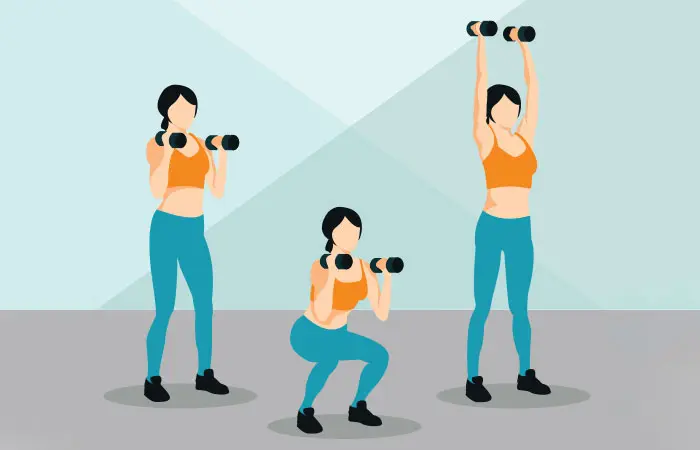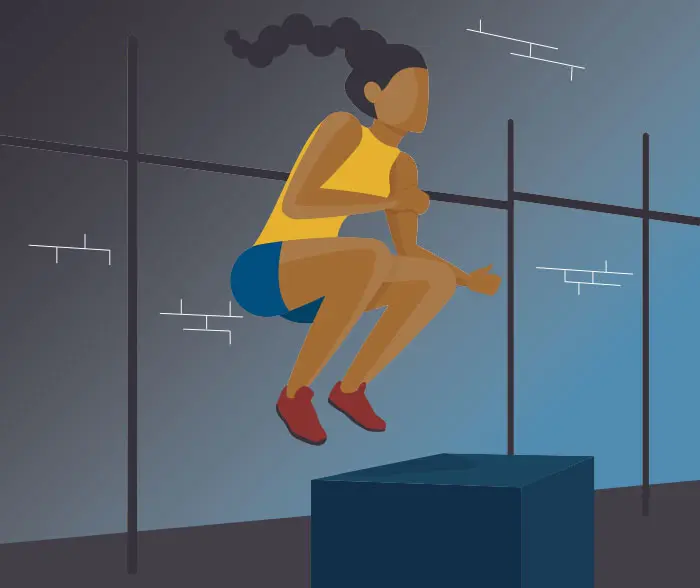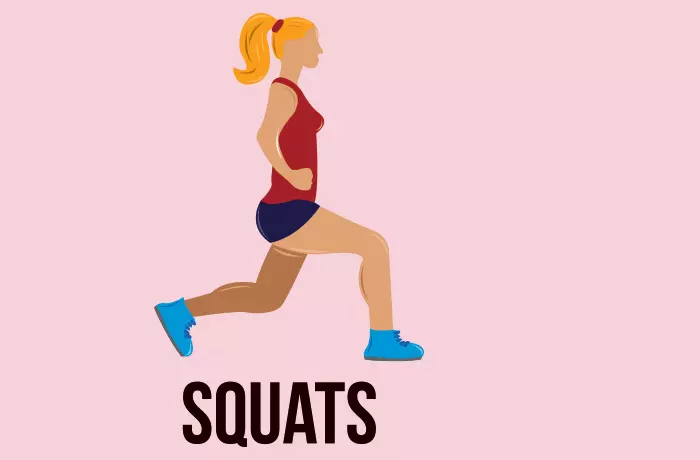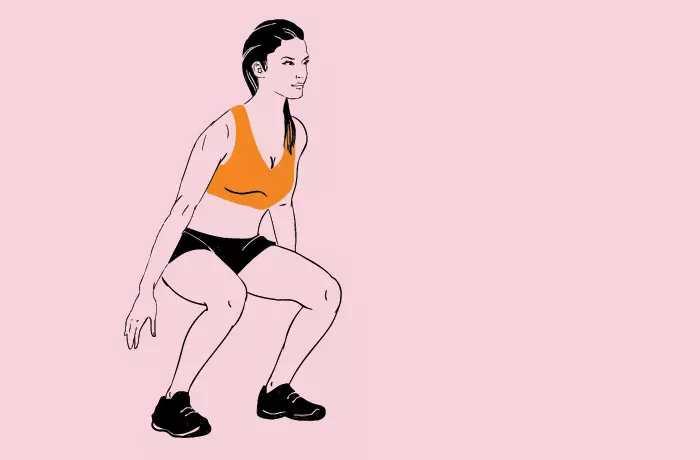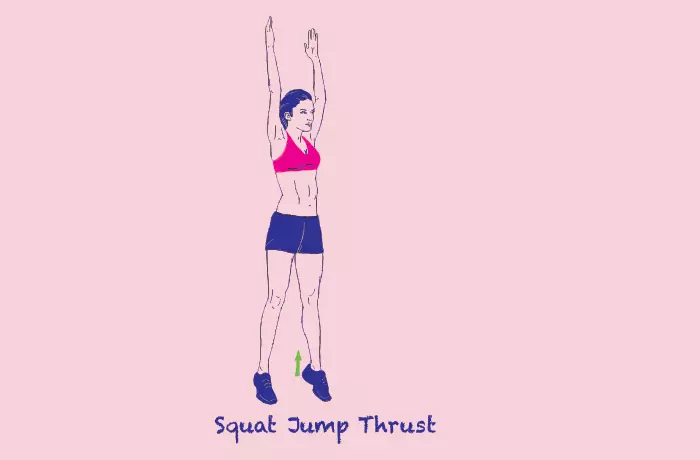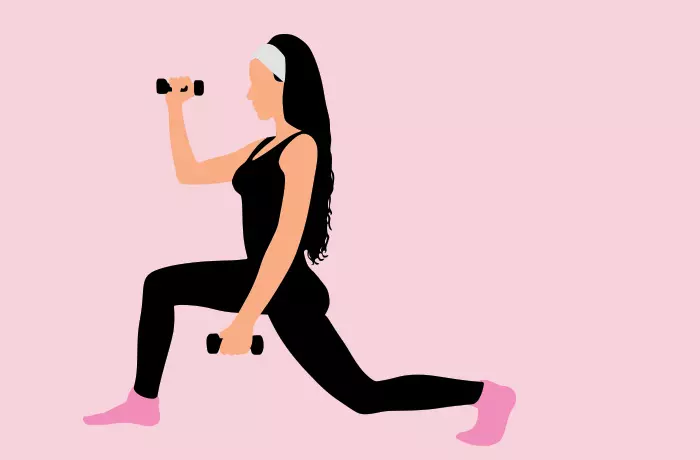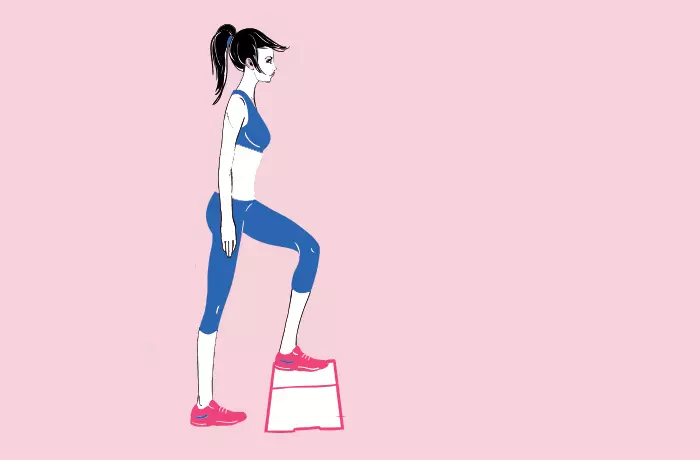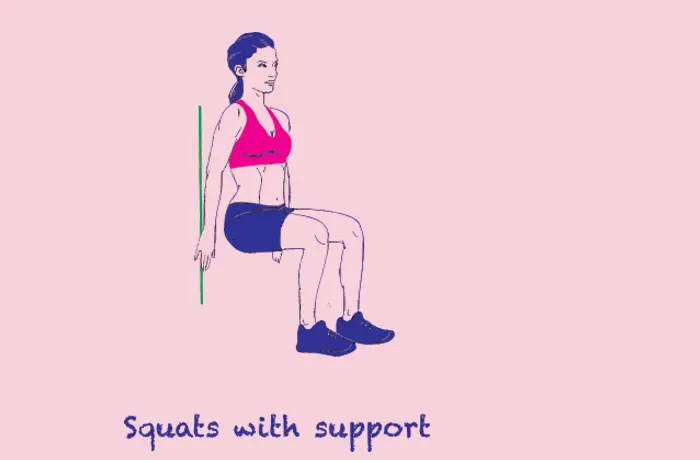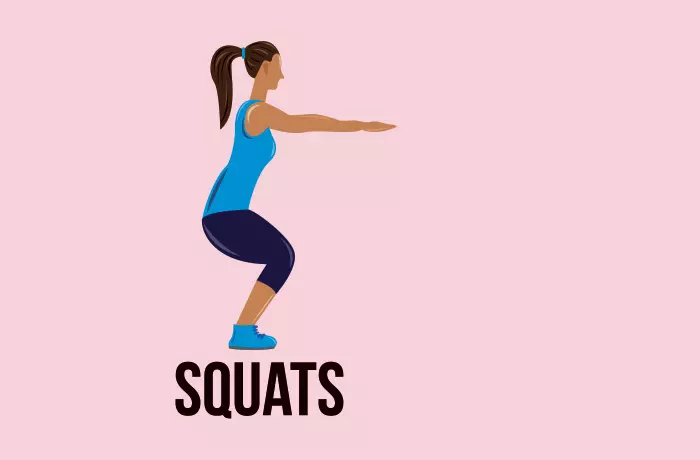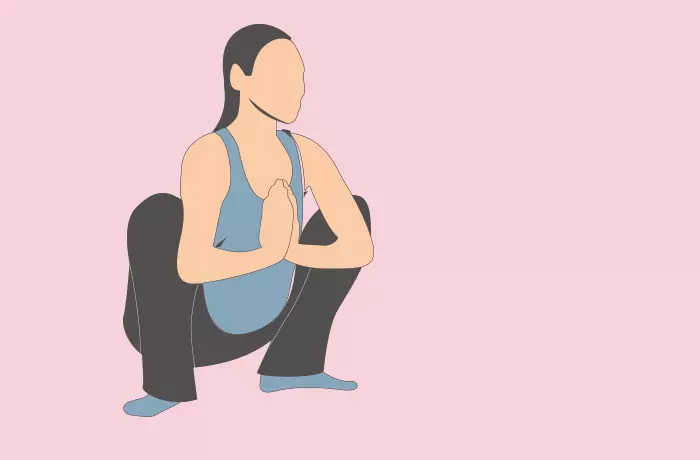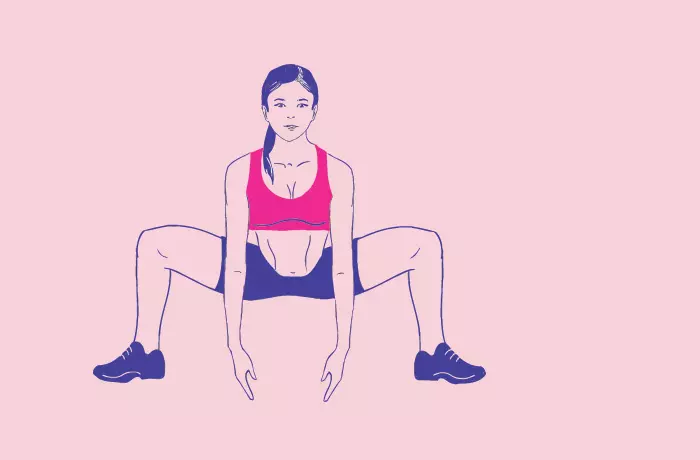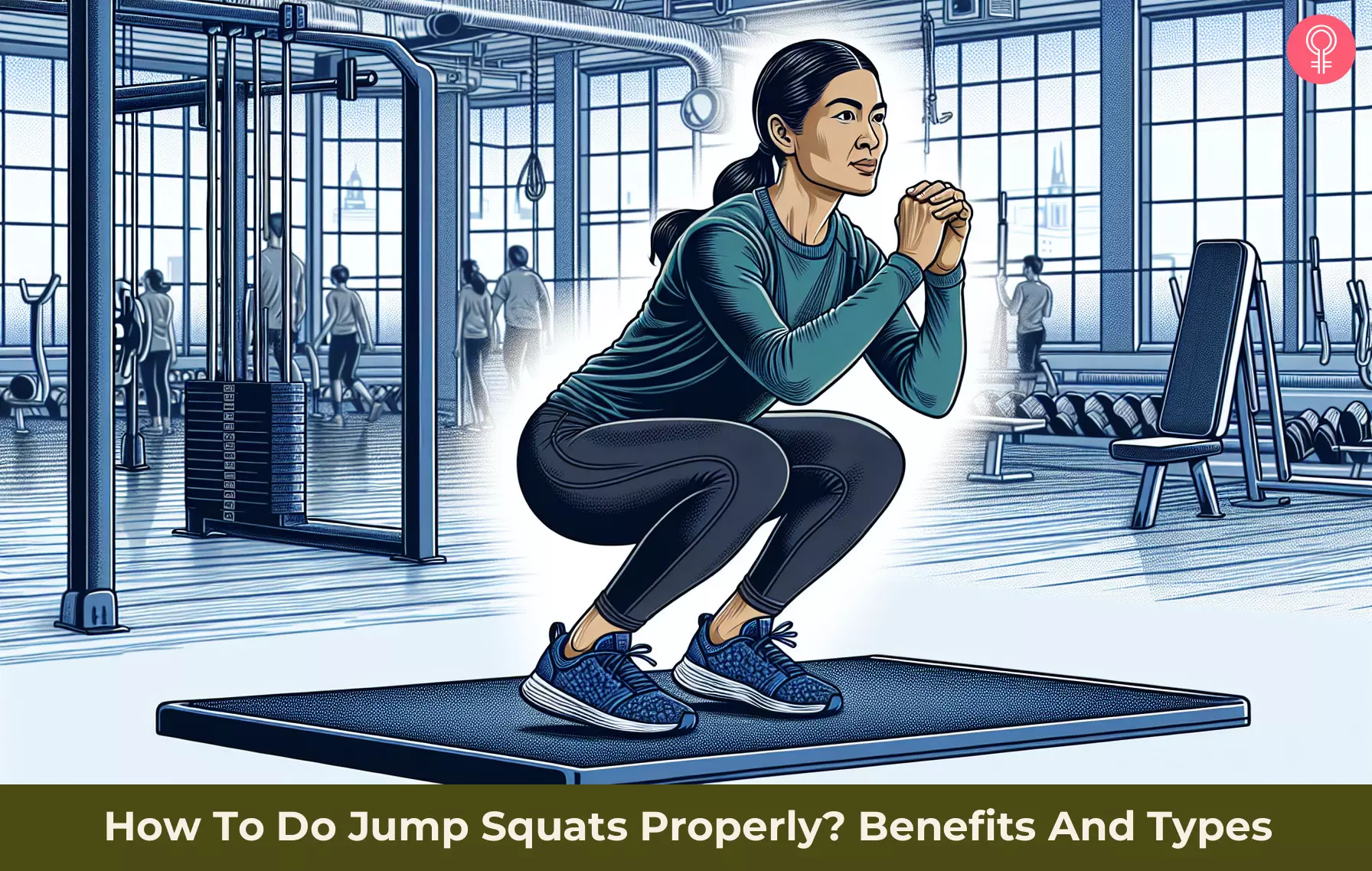How To Do Jump Squats Properly
If you are considering doing cardio exercises at home, your routine will greatly benefit from jump squats. However, if you do not do it properly you may get injured. Hence, for an effective and safe jump squat session, you need to keep a few things in mind. To begin, stand in front of a full-length mirror. Bend your knees a little, making sure that your spine remains upright. Now follow the guide below for detailed instructions on doing this exercise correctly.
Step By Step Guide To Do Jump Squats
via GIPHY
Jump squats tone many muscle groups. Check out the section below to know more about them.
Muscles Worked While Doing Jump Squats
Jump squats primarily target the lower body and engage various muscle groups. These include:
Quadriceps: These muscles help extend the knees during the upward jump phase. Hamstrings: They play a role in bending the knees and extending the hips. Glutes: They are activated when you extend the hips during the upward motion of the jump and the landing phase. Calves: They help you push off from the balls of your feet and propel you into the air. Core: They help stabilize your torso during the squat and jump and help you maintain proper form. Adductors: They help stabilize your legs during the squatting and landing phases.
Adding jumping squats to your leg and glutes exercise routine can help you reap the benefits listed in the next section.
Jump Squat Benefits
Jump squats have a variety of health benefits. They help build and tone the calves, glutes, hamstrings, and quadriceps, and also improve core stability. They have other benefits as well. We have listed some important ones here.
1. Burn Calories And Fat
Jump squats can help increase your metabolic rate, which is the rate at which the body burns calories at rest. Doing 30 jump squats burns about 100 calories, depending on your current weight and intensity of the exercise. Many women tend to accumulate fat in the lower body, which is linked to many health issues. Adding jump squats to your routine will help in calorie burning and shedding fat from the lower body.
2. Tone The Butt, Legs, And Ab Muscles
Jump squats are a plyometrici A type of exercise involving fast and repeated stretching movements within short periods to increase muscle strength and flexibility. version of normal squats. This high-intensity exercise helps tone the leg and butt muscles.
3. Maintain Mobility And Balance
Mobility and balance are crucial for movement, day-to-day tasks, and a better quality of life. Jumping not only increases mobility but also leads to proper and enhanced balance. As you get older, your leg strength decreases. Squats can help curb the natural weakening of these muscle groups. They help maintain motor balance and help improve brain-to-muscle communication. Note: Avoid doing jump squats if you have a leg injury or are recovering from one.
4. Boost Sports Performance
Scientific studies have concluded that squatting can help improve athletic performance, specifically in endurance exercises (2). This is why jumping squats are a part of most athletic training sessions.
5. Improve Health
Exercising has many health benefits. It helps improve glucose regulation, lipid metabolismi A process of breaking down fats as a source of energy and creating new fats for regulating hormones in the body. , and insulin sensitivityi Sensitivity of the body cells to insulin, a hormone facilitating the transport of glucose from the bloodstream to the cells. (4), (5). High-intensity cardio exercises like jump squats help reduce the risk of heart disease, hypertensioni A medical condition where the pressure of the blood is high on the artery walls, causing headaches and dizziness. , obesity, and diabetes (6).
6. Help With Waste Removal
Jump squats are a cardio exercise that improves body fluid circulation and increases sweating . These two actions help deliver nutrients to tissues, organs, and glands, and remove waste from the body (7).
7. Help Improve Bone Health
Jump squats can help improve bone density and aid bone health. Apart from regular jump squats, here are a few variations or other types of jump squats to improve your muscle endurance and tone, mobility, and balance.
Types Of Squat Jumps
1. Weighted Squats
2. Box Jump Squats
3. Single Leg Jump Squats
4. Frog Squats
5. Jumping Jack Squats
6. Prisoner Squats
7. Bicep Curl Squats
8. Uneven Squats
9. Wall Squats
These are regular squats done against a wall.
10. Regular Squats
Jihyun Yoo, a blogger, shares her experience after doing 100 squats daily for three months: “I used to go to the gym every other day. After squats, it makes me work out more. Sometimes I do 300–500 squats (i).” She adds, “I’ve been keeping track of my workout record with my cell phone and smartwatch. I’ve lost weight and [my] activities have increased. I’m getting in good shape.”
11. Monkey Squats
12. Sumo Squats
Do squats make your butt bigger? Squats and proper nutrition can help make your butt more shapely and rounder. Here’s a list of foods, exercises, and tips to get a bigger butt. Are jump squats safe? Yes, jump squats are safe. Make sure you wear good shoes. Avoid jump squats if you have a leg injury or are recovering from an injury or surgery. Do jump squats slim your thighs? Just doing jump squats will not help you get slim thighs. You must take care of what you eat and do cardio 3 days a week and strength training twice a week. Are jump squats bad for knees? Jump squats can injure your knees if you land hard, do not wear shoes that have shock-absorbing properties, or if your posture is bad. Your knees should not overshoot your toes and they should point diagonally out. What muscles do jump squats work? Jump squats work on glutes, hamstrings, quads, lower abs, and calves. Is it OK to jump squats every day? Yes, it is a great exercise to strengthen your lower body. Couple it with other exercises targeting your upper body to achieve your overall fitness goal. How heavy should jump squats be? According to anecdotal reports, the ideal load for jump squats is 20–30% of your best full back squat if you wish to maximize power production. Why are jump squats so hard? An effective jump squat needs good leg and ankle support. You need to be fluidly dynamic as your lower body muscles work overtime. It may be painful as your joints are stressed every time you land. How many jump squats are too much? It depends on your fitness level and your comfort with jump squats. It is recommended to gradually increase your reps, at most 25 reps of 5 sets.
Illustration: How To Do Jump Squats Properly? Benefits And Types
Jump squats are an amazing way to get fit! Watch this video to find out what happens to your body if you do them every day!
